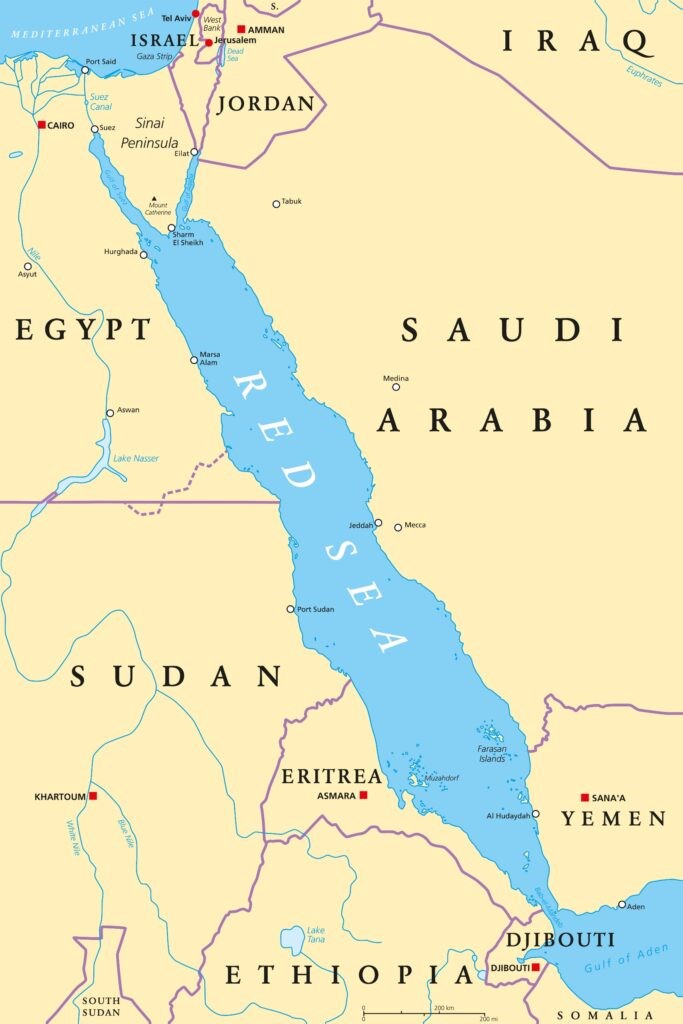Description

Disclaimer: Copyright infringement not intended.
Context
Global trade faces disruptions due to the Red Sea crisis, impacting Suez Canal routes and Gujarat exports.
Details
Red Sea
- The Red Sea, one of the most saline bodies of water in the world, is an inlet of the Indian Ocean between Africa and Asia.
- The connection to the ocean is in the south through the Bab el Mandeb sound and the Gulf of Aden.
- In the north are the Sinai Peninsula, the Gulf of Aqaba, and the Gulf of Suez (leading to the Suez Canal).
- The Sea has played a crucial navigational role since ancient times.
Countries bordering the Red Sea include:
- Northern shore: Egypt, Israel, Jordan
- Eastern shore: Saudi Arabia, Yemen
- Western shore: Sudan, Egypt, Eritrea
- Southern shore: Djibouti,Eritrea
Geology
- The Red Sea formed when Arabia split from Africa due to plate tectonics.
- This split started in the Eocene and accelerated during the Oligocene.
- The sea is still widening and it is considered that the sea will become an ocean in time.

Geography
- Occupying a part of the Great Rift Valley, the Red Sea has a surface area of about 174,000 square miles (450,000 km. It has a maximum depth of 8,200 feet (2,500 m) in the central median trench and an average depth of 1,640 feet (500 m), but there are also extensive shallow shelves, noted for their marine life and corals.
- Climate: The climate of the Red Sea is the result of two distinct monsoon seasons; a northeasterly monsoon and a southwesterly monsoon.
- Very high surface temperatures coupled with high salinities makes this one of the hottest and saltiest bodies of seawater in the world. The average surface water temperature of the Red Sea during the summer is about 26 °C (79 °F) in the north and 30 °C (86 °F) in the south, with only about 2 °C (3.6 °F) variation during the winter months.
- Salinity: The Red Sea is one of the most saline water bodies in the world, due to the effects of the water circulation pattern, resulting from evaporation and wind stress. Salinity ranges between 3.6 and 3.8 percent.
- The Red Sea water mass exchanges its water with the Arabian Sea and Indian Ocean via the Gulf of Aden. These physical factors reduce the effect of high salinity caused by evaporation and cold water in the north and relatively hot water in the south.
Living resources
- The Red Sea is a rich and diverse ecosystem. More than 1,100 species of fish have been recorded in the Red Sea, with approximately 10 percent of these being endemic to the Red Sea. This also includes around 75 species of deepwater fish.
- Other marine habitats include sea grass beds, salt pans, mangroves, and salt marshes.
- The World Wide Fund for Nature, has identified the Red Sea as a "Global 200"
Recent Development
- Over the past few months, global trade has been severely affected, primarily due to the disruption in one of the critical shipping routes — through the Red Sea.
- Attacks on vessels in the Red Sea region have reduced traffic through the Suez Canal through which about 15% of the global maritime trade volume passes.
Impact on India
- The Suez Canal is the shortest maritime route between Asia and Europe and, therefore, the disruption has had a critical effect on exports from India, particularly from Gujarat.
- Amid worries about delayed shipments because of the brewing Red Sea crisis, exporters were compelled to turn to air cargo despite higher costs. The crisis had a greater impact on exports of food products, textile, pharmaceuticals, and engineering goods.

- About 50% of the country’s pharma industry revenues come from exports to the US and Europe. As almost two-thirds of Indian pharma exports take place through the sea route, costs are a key concern for pharma
- Non-perishable cargos like textile, auto parts and electronics, which are in demand due to the festive season in the Middle East and Europe, are also taking the air route.
- Across commodities, including pharma, textile, agriculture and medical devices, the cargo terminal has witnessed an increase of 35% in volumes, which have been diverted from the sea route to the air route.
- The crisis has led to an increase in the cost of sea freight also because of a 15-20% rise in insurance premiums.
|
PRACTICE QUESTION
Sea Bordering country
- Adriatic Sea Albania
- Black Sea Croatia
- Caspian Kazakhstan
- Mediterranean Sea Morocco
- Red Sea Syria
Which of the pairs given above are correctly matched?
- 1, 2 and 4 only
- 1, 3 and 4 only
- 2 and 5 only
- 1, 2, 3, 4 and 5
Answer 2
|

















